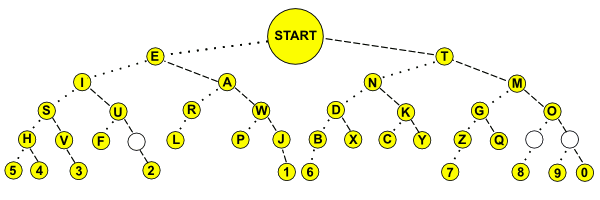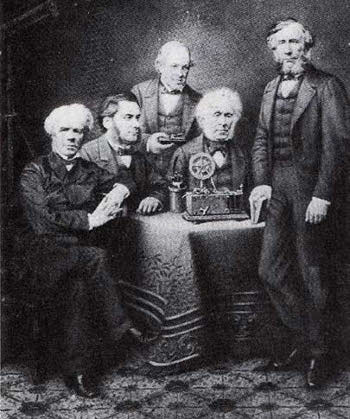
The Telegraph
July 25, 2011 Today, July 25, is the anniversary of the first successful demonstration, in 1837, of a commercial telegraph system. No, Samuel F.B. Morse wasn't involved, although his system was operational the following year. This telegraph was operated between Euston and Camden Town in London. It was based on an invention of William Fothergill Cooke and Charles Wheatstone, who had patented the device, originally as an alarm system, in May of that same year. There was a precedent for their work. Another Englishman, William Watson experimented with electricity about the same time as Benjamin Franklin. In 1747, Watson showed that electricity could be transmitted through a wire, using the Earth as a circuit return path. Watson was apparently the first to consider the idea of charge conservation.[1] Not much is written about Cooke, who saw an early demonstration of a telegraph, by a Professor Moncke, in Heidelberg, Germany. He experimented with telegraphy on his own, but it wasn't until he teamed with Charles Wheatstone that real progress was made. As their collaboration evolved, Cooke assumed the role of the "money man," and he possessed practical engineering skills, whereas Wheatstone had a deep scientific knowledge of electrical circuits.[2] Their joint venture was not an easy one, with each claiming priority over the other. An arbitration proceeding in 1841 decided that the two had contributed equally to the invention.[2] There was a falling out between the two. Cooke formed his own company, the Electric Telegraph Company, in 1846, and he bought their joint patents. Both Cooke and Wheatstone were knighted, but Cooke received his honor a year after Wheatstone.[2] portrait painter. He was in Washington, D.C., away from his home in New Haven, Connecticut, painting a portrait of the Marquis de Lafayette, when he received news that his wife was ill. The news arrived via a messenger on horseback, Morse immediately returned home, but his wife died before he arrived. He reasoned that if he had received the news earlier, he would have been at her bedside. At that point he devoted himself to the problem of telecommunication. As a portrait painter, Morse was not especially skilled in the electrical arts, so he obtained advice from Leonard Gale, a professor of chemistry at New York University who knew Joseph Henry. Henry, of course, was especially skilled in electrical circuitry. Alfred Vail, who had technical skill and family money, joined Morse in his venture. On January 11, 1838, Morse and Vail demonstrated a telegraph system with a two mile range at the Speedwell Ironworks in Morristown, New Jersey. The Morse system was different from the Cooke-Wheatstone system, since it was a single wire with a ground return completing the electrical circuit. Many demonstrations later, the US Congress paid Morse to build an experimental telegraph line between Washington, D.C. and Baltimore, Maryland, along thirty-eight miles of the Baltimore and Ohio Railroad rail line. This telegraph line was inaugurated on May 24, 1844, when Morse sent his famous telegraph message, "What hath God wrought." After that hurdle, Morse founded the Magnetic Telegraph Company in May, 1845, to extend telegraphy between other cities. Morse is known best today through the eponymous Morse Code. Thomas Edison is known to have nurtured his "brand" by asserting himself to have invented everything relating to his work. Morse was much the same, and there's evidence that Vail is the actual inventor of Morse Code. Binary tree of Morse code letters and numbers. Dots are to the left, and dashes are to the right. Modified for clarity from Wikimedia Commons.
I wrote about the Morse Code in a previous article (Morse Code, July 3, 2008). Since certain letters of the alphabet are used more often than others, Morse (or Vail), created the code to make the more common letters easier to transmit. In the code, "e" (frequency of occurrence 12.7%) is a single dot, and "t" (9.1%) is a single dash. The modern version of Morse's code is slightly different from the original scheme, but it follows the same principle that less common characters are represented by longer sequences.[3]
As if a prelude to Alexander Graham Bell's legal struggle to secure rights to his telephone, Morse's telegraph patent was routinely contested and infringed. Finally, in 1853, The US Supreme Court ruled that Morse had been the first to combine electrical elements into a practical telegraph. The Court did rule (O'Reilly v. Morse) against applicability of the Morse Code apart from the telegraph implementation. This ruling confirmed the idea that an abstract idea is not patentable, only its implementation.
Morse Code was not the only problem in O'Reilly v. Morse. Morse also attempted to claim all electromotive means for printing characters, something that the court determined was a "principle" and not a mechanism that could be protected by a patent.
I'll leave you with a quotation from Morse's patent,[4-5] and a little code practice. If your code is a little rusty, you can refer to this chart. I confess that I remember only half the characters, but that's enough of a clue to decode the message.
Binary tree of Morse code letters and numbers. Dots are to the left, and dashes are to the right. Modified for clarity from Wikimedia Commons.
I wrote about the Morse Code in a previous article (Morse Code, July 3, 2008). Since certain letters of the alphabet are used more often than others, Morse (or Vail), created the code to make the more common letters easier to transmit. In the code, "e" (frequency of occurrence 12.7%) is a single dot, and "t" (9.1%) is a single dash. The modern version of Morse's code is slightly different from the original scheme, but it follows the same principle that less common characters are represented by longer sequences.[3]
As if a prelude to Alexander Graham Bell's legal struggle to secure rights to his telephone, Morse's telegraph patent was routinely contested and infringed. Finally, in 1853, The US Supreme Court ruled that Morse had been the first to combine electrical elements into a practical telegraph. The Court did rule (O'Reilly v. Morse) against applicability of the Morse Code apart from the telegraph implementation. This ruling confirmed the idea that an abstract idea is not patentable, only its implementation.
Morse Code was not the only problem in O'Reilly v. Morse. Morse also attempted to claim all electromotive means for printing characters, something that the court determined was a "principle" and not a mechanism that could be protected by a patent.
I'll leave you with a quotation from Morse's patent,[4-5] and a little code practice. If your code is a little rusty, you can refer to this chart. I confess that I remember only half the characters, but that's enough of a clue to decode the message.
"Be it known that I, Samuel F.B. Morse, now of Poughkeepsie, in the county of Duchess, in the state of New York, have invented a new and useful apparatus for and a system of transmitting intelligence between distant points by means of electro-magnetism, which puts in motion machinery for producing sounds or signs, and recording said signs upon paper or other suitable material, which invention I denominate the American Electro-Magnetic Telegraph..."
.-- .... .- -
.... .- - ....
--. --- -..
.-- .-. --- ..- --. .... -
References:
- Sir William Watson, archived copy of http://www.geocities.com/neveyaakov/electro_science/watson.html, October 19, 2002.
- Sir William Fothergill Cooke 1806-1879, The Institution of Engineering and Technology
- Tony Long, "June 20, 1840: A Simple Matter of Dots and Dashes" (Wired News, June 20, 2008).
- Samuel F. B. Morse, "Improvement in the Mode Of Communicating Information by Signals by by Application of Electromagnetism," US Patent No. 1,647, June 20, 1840.
- Samuel F. B. Morse, "Improvement in Electro-Magnetic Telegraphs," US Reissue Patent No. RE117, June 13, 1848.
- Transatlantic Communications, This Blog, August 15, 2007.
- Sir William Fothergill Cooke 1806-1879, The Institution of Engineering and Technology
